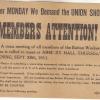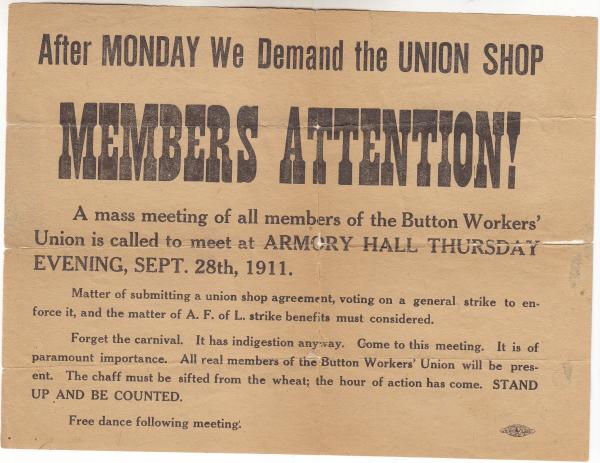The Muscatine, Iowa Strike
| Grade | 9th -12th Grades | Class | U.S. History | Length of Lesson | 45 Minutes |
| Lesson Title | The Muscatine, Iowa Strike |
| Unit Title | Post Industrial Revolution and Early 20th Century Technology |
| Unit Compelling Question | Did rapid industrial revolution make peoples' lives better or worse? |
| Historical Context: 2018.010.009 During July of 1899, disagreements rose over the costs of tools and wages paid to employees. Between 1899 and 1900, nine strikes took place. Eventually the Button Workers' Protective Union was formed in November, 1910. The Union helped organize a large strike in February of 1911 following the closure of 43 sites. They blamed overproduction as a reason and organized picket lines outside the factories. A total of 2,300 protesters went on strike and during the following months, the strike gained national attention. Muscatine police along with hired police from Chicago and St. Louis worked with the union to sign a peace agreement in May of 1911. The strike officially ended in in the spring of 1912. |
|
| Lesson Supporting Question | |
| Lesson Overview | Students will be in groups and begin by examining this bulletin. They will read it and write an assumption about what is the problem. The date should be a hint. We have covered a little bit of industrialization so this is not a surprise. Teacher will ask what they believe this to be about. Each group will share out. This will be followed by the rest of the information they do not know yet. Disagreements between costs of tools and payments to workers. Creation of Unions to help.
|
| Primary Sources Used |
|
| Resources Needed | https://docs.google.com/document/d/1EJr1YMNoY6wNqmBKo842lAYka7NaJoxwXLF3atDFeew/edit http://www.iptv.org/iowapathways/artifact/pearl-button-factory-muscatine-ia-ca-1912
|
| Standard | |
| Lesson Target | Students will be able to make an argument for, or against, rapid industrialization. |
| Lesson Themes | Types of Business and Industries, Workers, Cities, Innovators |
|
| Formative Assessment (How will you use the formative assessments to monitor and inform instruction?) |
When the students are asked to present their ideas about what the document could be about, they will be showing me how well they can interpret document and bring back information from previous lessons about industrialization. |
| Summative Assessment (How does the lesson connect to planned summative assessment(s)?) |
The worksheet will be the summative assessment, primarily focusing on what the document is saying, what we can take away from it, what working in the factory conditions were like, and the results on the population. |
| Author | Caleb Hovenga | Created | Last Edited | ||||
| Reviewer: Chad Christopher, History Education, University of Northern Iowa | |||||||
| Lesson Plan Development Notes: Teaching Methods, University of Northern Iowa, Fall 2019 | |||||||


